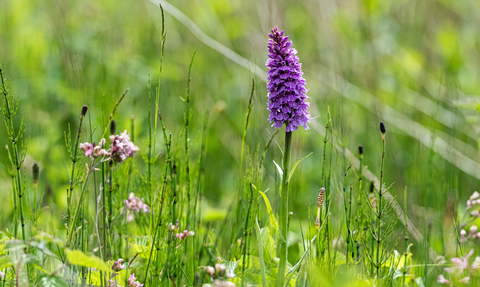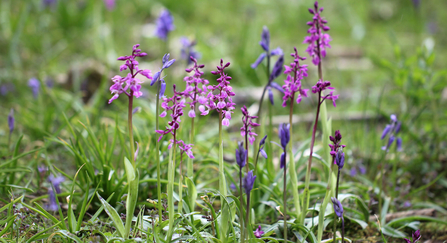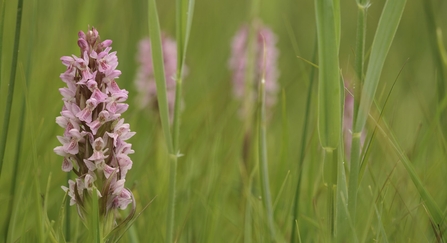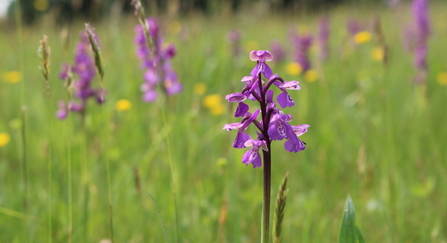
Ail Meadow Southern Marsh Orchid (c) Paul Lloyd
Where to see orchids
In May, June and July a succession of rare orchids flower in abundance in Herefordshire in our wildflower meadows. Here's our pick of the best Nature Reserves to see these exotic flowers.
Lea & Paget's Wood
The orchid display at Lea & Pagets Wood starts with early purple orchid rising among the wood anemones and bluebells in spring and continues in summer with the bird’s nest orchid with its brownish-yellow flower spike and the delicate greater butterfly orchid. To spot this orchid, scan the woodland floor for tall spikes of 10-40 white and green flowers. The vanilla scent produced by the flowers is more noticeable in the early evening.

Early purple orchids (c) Jim Higham
Parish Field
Once a traditionally managed hay meadow, this wet meadow hosts a number of important orchids. One is the fragrant orchid which lives up to its name, producing a sweet, orangey smell that is very strong in the evening. Look for its densely packed, pink flower spikes amongst the grasses. Also seen here are the southern marsh orchid with darker pink-to-purple flowers which has a tendency to hybridise with the pale pink common spotted orchid also found here.

Southern-marsh orchid (c) Terry Whittaker/2020VISION
Leeping Stocks
In the south of Herefordshire, Leeping Stocks is another site to see greater butterfly orchid – in abundance is some parts of the reserve. There are also white and broad-leaved helleborine, both orchids. The white helleborine carries up to 16 white flowers on an upright stem in contrast with the broad-leaved helleborine which has greenish, purple-tinged flowers that look a little 'drooping'. Active management of the woodland floor ensures these rare orchids continue to flourish.

Greater butterfly orchid (c) Philip Precey
Birches Farm
In May, June and July a succession of rare orchids flower in abundance making this the best site in Herefordshire to see so many different orchids. Alongside common spotted and early purple orchid seen on our other reserves, are frog, pyramidal, twayblade and green-winged orchids. The early purple and green-winged orchids are both purple and easily confused as they flower at similar times, however look out for spots on the leaves as they belong to the early purple. The small pyramidal orchid lives up to its name - its pink flower spike forms a pyramidal shape. In the morning, this orchid has a sweet vanilla scent to attract pollinating butterflies.

Green-winged orchid (c) Lianne de Mello
Bodenham Lake
Bodenham Lake is one of the few places in Herefordshire to see the rather exotic bee orchid. At the eastern end of the site, the soil in the scrub area is nutrient poor and provides ideal growing conditions for the bee orchid. The flower’s velvety lip with yellow markings mimics a female bee that appears to be feeding on three pink petals. This attracts a male bee to pollinate the flower as it moves from one flower to another transferring pollen. In spite of all that effort and trickery, bee orchid flowers are primarily self-pollinating.

Bee orchid (c) Philip Precey
